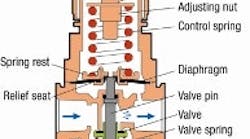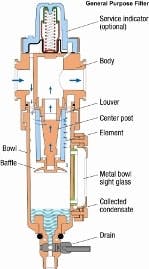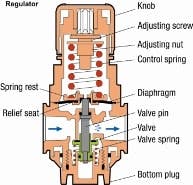Your back-to-the-basics primer on filtering, lubricating, and regulating compressed air
Compressed air moves the machines that make the things we work (and play) with every day. To maximize the efficiency and service life of pneumatic tools and equipment that push, pull, lift, position, or convey, compressed air must be clean, dry, and delivered at the appropriate pressure. A basic understanding of air preparation – filtration, regulation and lubrication – will help plant engineers and maintenance staff keep things running smoothly.
Compressing air concentrates contaminants and moisture, which cause premature wear and tool damage. The right filter removes particles and water. Air leaves the compressor at higher pressure than most end uses require, so regulating the flow to the correct pressure prevents damage and improves efficiency. Finally, compressed air is an efficient way to deliver lubrication to tools continuously, so adding lubrication to clean, regulated air prolongs tool life and protects performance.
Filters
There are three main types of filters: general-purpose filters for removing moisture and particles, coalescing filters for removing oil aerosols, and activated carbon filters for removing oil vapors.
General-purpose filters are used for most applications. Uses include main headers, branch lines, tools, cylinders, valves, and valve circuits. They are available in different pipe sizes and filtration levels, typically ranging from 40 microns down to 5 microns. They work by centrifugally removing entrained liquids and dirt, which then fall to the bottom of the bowl. A baffle quiets the air turbulence and prevents re-entrainment. The air, now free of water droplets and large particles, passes through the filter element, which removes small particles. The condensate at the bottom of the bowl exits through a drain operated manually or automatically. (Figure 1)
Figure 1: General-purpose filter. Source: IMI Norgren
Oil-removal filters are used where very clean, oil-free air is required, such as for supply to fluidic devices, air gauging equipment, and air bearings. Oil mist coalesces as air passes through the filter’s fine fibrous filtration media. Oil droplets are collected in the outer sock (saturation will be clearly visible and is normal) and then drop to the bottom of the bowl for removal through a drain.
Activated-carbon filters are used where oil vapor in the air is not acceptable, such as with instrumentation or paint spraying. The porous structure of activated carbon results in a large surface area to which oil vapors are attracted and adhere.
Filter elements that remove fine particles, oil droplets, or oil vapor will last longer and perform better if a general-purpose prefilter is placed upstream to remove water and larger particle contaminants first.
The service life of a filter element depends on the quality of the inlet air. In general, air service equipment should be maintained annually, but use, air quality and condition at inspection may dictate adjusting the maintenance interval. Elements in activated carbon filters should be replaced every 1,000 hours or when odor is detected.
Regulators
Pressure regulators are used to reduce pressure to the level required for downstream equipment, limit the force of cylinders, or minimize pressure variation at point of use.
General-purpose regulators are designed to deliver maximum flow capacity (based on size) while maintaining outlet pressure to the set level accurately. (Figure 2) General-purpose regulators are available in relieving and nonrelieving types.
Figure 2. General-purpose regulator. Source: IMI Norgren
Relieving regulators can be adjusted from a high pressure to a low pressure. Even in a dead-end configuration, relieving regulators will allow excess downstream pressure to exhaust.
Nonrelieving regulators will not allow downstream pressure to escape when they are adjusted. The trapped air needs to be released some other way, such as by operating a downstream valve.
Pilot-operated regulators are used in high-flow applications and where access to the main regulator is limited. This type of regulator does not use a control spring. Instead, an air pilot signal controls the outlet pressure of the main regulator. This air pilot signal is controlled by a small pilot operator regulator. Pilot-operated regulators are typically more precise than spring-operated general-purpose regulators.
For even greater control of outlet pressure, a “feedback” pilot regulator can be used. Here, the piloted regulator outlet pressure from the pressure-critical point in the system can be fed back to the controlling pilot regulator, which adjusts pressure accordingly. Feedback systems are very responsive to downstream pressure requirements. Note that very few applications require feedback, so in many cases a general-purpose regulator is an acceptable choice for a pilot regulator.
Filter/regulators
Filter/regulators combine the features of a filter and a regulator in a single compact body. Air passes through the filter section first, removing water and particles. This clean air is then regulated by the top regulator section.
Lubricators
Most pneumatic equipment, even prelubricated components, will last longer if oil aerosol is continually added to the compressed air that powers them. Without lubrication, environmental factors such as extreme temperatures and excessive moisture and operational factors such as startup and operation friction reduce the service life of most working pneumatic devices. Used oil exiting the compressor is dirty and degraded, so it cannot function as a lubricant.
Aerosol lubricators automatically deliver a metered amount of oil into the air path of operating pneumatic equipment. Lubricators function by creating a pressure drop that causes oil to be siphoned into an adjustable dome. An operator can set the amount of oil to be delivered by observing the drip rate and using the dome adjustment.
Operating manuals for pneumatic equipment typically specify the amount of oil required to keep the device operating optimally. Lubricators should be adjusted to deliver the amount of oil specified at defined operating conditions and then be validated after the equipment is in operation.
Figure 3. Micro-fog lubricator. Source: IMI Norgren
Oil-fog (also called direct-feed) lubricators are the most commonly used. These lubricators deliver 100% of the oil drops seen in the dome directly into the air stream. Oil particles traveling downstream are normally 2 microns or larger. Because of gravity, these particles will remain airborne only for a short distance – up to about 15 feet – and they normally will not travel up or follow intricate flow paths. As a result, oil-fog lubricators should be located in-line and near the tool they are lubricating. They are very efficient at delivering the right amount of oil directly to the cylinder, valve, or tool.
Micro-fog lubricators atomize the oil drip into particles smaller than 2 microns. Approximately 10% of the oil drip seen in the dome is transported into the airflow, and the rest of the oil is returned to the bowl for future use. Because the particles are small, they can travel long distances, vertically, and through intricate flow paths to multiple tools. Also, because only 10% of the oil is being delivered downstream, micro-fog lubricators are good for applications that require better adjustability of small amounts of direct lubrication. (Figure 3)
Filter/regulator/lubricator
A lubricator is used downstream from a filter and regulator that precondition the air. These can be stand-alone components or an integrated filter/regulator/lubricator (FRL). In many applications, a space-saving FRL combination will reduce installation complexity and cost and make maintenance easier. FRLs can be composed of filters with different filtration levels and with oil-fog or micro-fog lubricators.
Pneumatic devices that push, pull, lift, position, or convey last longer and perform better when powered by compressed air that is clean, dry, pressure-regulated, and lubricated.
Charles Werdehoff is FRL product marketing manager for the Americas at IMI Norgren, where he has worked for more 35 years. In addition to air preparation experience, Werdehoff has extensive manufacturing experience. Contact him at [email protected].




